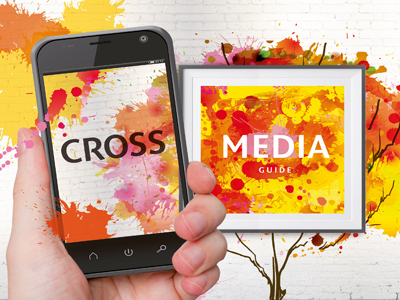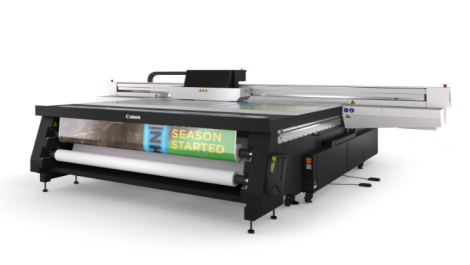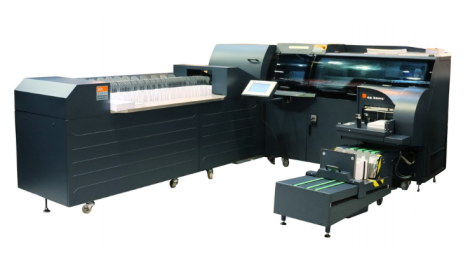Cross media, multi-channel marketing, marketing automation – there’s a plethora of terms that relate to combining print with online communications to achieve marketing objectives, but whatever you call it, it is still an opportunity. Michael Walker sorts the printers from the marketing service providers.
According to market analyst InfoTrends the cross media market is alive and well, growing 15% in 2013 and predicted to hit a compound annual growth rate of 18% over the next three years. Cross media print volume accounted for around 9.5% of total print in western Europe in 2014 and is expected to double in the next three years.
These are healthy figures, but the growth so far is not all driven by printers:
‘Over half of cross media marketing software revenue comes from hosted solutions, much higher than any other production software category,’ said Kaspar Roos, director of Production Software Services at InfoTrends. ‘This can be attributed to the rapid adoption rate of new online technology from corporate marketing and agencies. Uptake has been slower amongst print services providers, but there is growing interest.’
Mr Roos points to vendors beginning to differentiate their offerings between campaign creation and campaign execution, the modular approach allowing them to reach customers who may not need or be able to afford a complete end-to-end solution.
These recent figures contrast with a 2011 InfoTrends report, referenced in Canon’s Cross Media Guide published in late 2014; then, a survey of 285 print service providers revealed that 58% were already offering some level of cross media service, and a further 29% said they were planning to introduce them within the next 24 months.
So have printers missed the cross media boat? There seems to have been an upsurge of interest from the marketing agency and corporate markets, likely driven by the desire for accurate measurability and return on investment calculations that digital interactions provide.
Kevin O’Donnell, marketing manager, Graphic Communications Operations Europe at Xerox, says there are three markets for the XMPie family of products – corporate users, particularly within the public sector, the company’s ‘traditional’ base amongst digital printers, and an increasing interest from the creative industry.
This view is echoed by Neil Bather, managing director at Transeo, the long-standing UK distributor for DirectSmile, which was acquired by EFI at the end of 2014, who said: ‘We started with print, what we know, but we now also have customers who are marketing agencies and “users”, people doing their own marketing rather than providing it as a paid service.’ The corporate and franchise market is also a big part of the business for PTI’s Marcom Central, though the FusionPro VDP line is more heavily used by printers. PTI was acquired by Ricoh in December 2014 and is in the early stages of being rolled-out across Europe as well as being used internally.
Simon Ellington at ROI360, which builds services around the PageFlex suite of products, also reports an upturn in enquiries from marketing service providers (MSPs) and says that he is not seeing widespread adoption amongst printers. However, Antony White, European group product marketing manager at Canon, said it has seen ‘a stronger uptake in medium to large commercial printers and communications/marketing agencies with a focus on direct and data based marketing than in print rooms serving corporate clients,’; he reports a growth of 87% in cross media related software sales in 2014 over the previous year.
What’s in a name?
One reason that the cross media uptake picture may seem confused could be the terminology. Simon Ellington contends that the phrase ‘cross media’ is a term invented and used by the print industry and one that is not necessarily understood outside it, suggesting that ‘multi-channel’, ‘omni-channel’ and ‘pull marketing’ are more relevant terms to the people running the campaigns. Then there is marketing automation, which is more concerned with setting up, running and analysing entire campaigns, though the products that do this can usually generate the print components too. MindFire Studio, which MindFire co-founder David Rosendahl describes as ‘multi-channel multi-touch marketing automation’, is one such product.
Canon makes a distinction between multi-channel, which it sees as the use of multiple channels simultaneously but independently, and cross media, in which there is direct and mutually-supportive interaction between channels, as might be achieved using QR codes or augmented reality, or ordering personalised print online. Floris Dansen, product line manager at Objectif Lune argues that cross media started ‘a long time ago, with TV shows where you could call in; now we do that with apps’, but says that today cross media is ‘a marketing activity that uses multiple channels where response can be measured and A/B testing can be carried out’. Mr Dansen also draws a distinction between products like Objectif Lune’s, which he says come into play once the customer relationship is established, and are more about customer service than customer acquisition, and those that are more marketing orientated. GMC, whose Inspire suite supports transactional and transpromo applications, also falls into this area.

Transeo Media’s Neil Bather
Print is pivotal
Whether cross media communications are aimed at gaining customers or improving existing relationships with them, it is very clear that print plays an essential role. Figures from Canon’s 2012 Insight Report ‘The Bigger Picture’ suggest that print and websites are both crucial, each appearing in 94 per cent of multi-channel campaigns, with email at 82 per cent and social networking at 64 per cent. The channels that support personalisation are showing the fastest growth, at the expense of conventional broadcast media and one-to-many channels.
Thanks to variable data printing (VDP) tools, which are embedded within or explicitly supported by cross media production software, pretty well all of which has its roots in print, printed output is every bit as customisable as emails or other digital channels, with the added benefits of the physical and tactile attributes of paper to reinforce quality and perceived value. The question for printers is how to get involved with it.
The options fall into two categories: look to do the variable data printing part of cross media campaigns for someone who is not equipped to do it, typically a direct marketing agency or a corporate client; or offer a full cross media service themselves. The first option might look vulnerable to the same commodity buying process that has eroded margins on static print, but variable data printing is a valuable skill in itself and, once mastered, provides a good basis for expanding into online channels.
The data divide
The main hurdle for many printers looking to move into VDP and from there into cross media, is acquiring and handling customer or prospect data. Xerox’s Kevin O’Donnell sees a print customer’s lack of data as an opportunity, rather than a reason to ignore cross media: ‘The print is just the tip of the iceberg; the printer could run a campaign to acquire the data, offering their customer clean data and analytics too.’ He admits though that for some ‘it can seem quite daunting, especially in the areas of compliance and security’.
Another route to data acquisition is to buy it in. ROI360’s Right Market module allows intuitive data selection from a set of more than 40 million UK households, with neat features like the ability to select recipients based on location via visual interaction with on-screen maps, plus a range of demographic and other selection criteria. ROI360 also offers an online ‘campaign as a service’ option where it provides the back-office functionality so that its print customers can offer a complete package to their clients. This sort of capability is also possible with the Objectif Lune and MindFire solutions, though these require the printer to manage the portal and campaign creation as well as handling the printing and online fulfilment.
Managing the creation of a cross media campaign is getting simpler, though. Transeo’s Neil Bather stresses DirectSmile’s ease of use and speed of campaign building: ‘If you can create a nice-looking document, you don’t need programming skills to execute a campaign,’ he said. XMPie has recently introduced uMerge, a plug-in to Adobe InDesign that allows personalisation within the creative application and links to ‘full’ XMPie sites for production and fulfilment. Objectif Lune has completely revamped its product line, switching to HTML-based composition throughout, but with support for print in PDF/VT or standard PDF via a conversion utility. PlanetPress Connect is available now and Printshop Mail Connect will be available in the second half of the year.
The digital press vendors are also keen to help their customers expand beyond the print-only business model. Benoit Chatelard, general manager for Solutions at Ricoh Europe says that Ricoh has put in place consultancy and methodology expertise to support its PTI acquisition. ‘It’s most important to make different departments work together – marketing, print and IT – and we can act as a mediator or facilitator here,’ he said.

Antony White, Canon
Antony White at Canon says that the vendor strongly encourages cross media prospects to participate in its Essential Business Builder Programme courses, adding: ‘Ideally, there should be some market ‘pull’ from established clients, as relatively few printers have the resources to promote themselves strongly as marketing service providers.’ He added that lack of knowledge and experience among printers and print buyers are among the major factors holding back faster growth.
Xerox reports an increase in placements and training sessions around its two-year-old XMPie Media Lab venture. Perhaps summarising the whole cross media sector, Kevin O’Donnell said: ‘We’ve moved on from ‘does it work?’ to ‘how do I do it?’.





